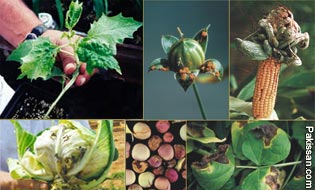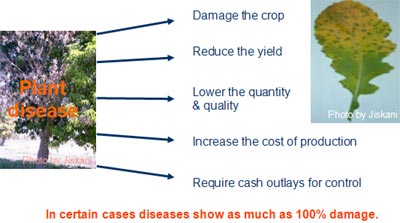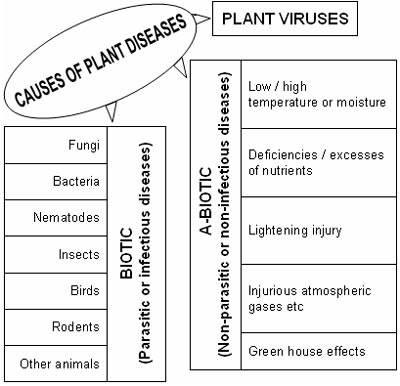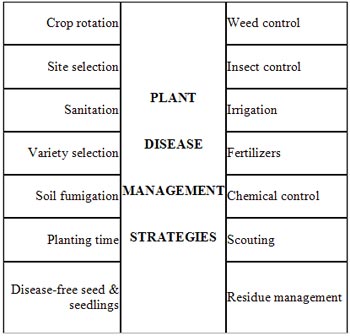Diseases of crops
Causes, Symptoms, Identification, Transmission and
Control
By
M. Mithal Jiskani
Assistant Professor, Department of Plant Pathology
Faculty of Crop Protection,
Sindh Agriculture University Tandojam (www.sau.edu.pk),
760060
Email: mithaljiskani@hotmail.com,
mithaljiskani@yahoo.com
 Plant
diseases damage the crop, reduce the yield, lower the
quantity and quality, increase the cost of production
and require cash outlays for material and equipment for
control measure. The chemicals used for disease control,
are equally poisonous for all livings including human
being and are also main cause of environmental
pollution. In certain cases, fields have been found to
show as much as 100% damage.
Plant
diseases damage the crop, reduce the yield, lower the
quantity and quality, increase the cost of production
and require cash outlays for material and equipment for
control measure. The chemicals used for disease control,
are equally poisonous for all livings including human
being and are also main cause of environmental
pollution. In certain cases, fields have been found to
show as much as 100% damage.
The readers including farmers, students, and research and
extension workers would be able to understand:
What is
plant disease and disease complex?
How the
plant diseases are important?
Which
are the causes of plant diseases?
To what
we may call the symptom?
Basic
principles for identification of diseases.
Dissemination or Transmission of diseases.
Disease
management or control.
BACKGROUND
Biology (Greek words: Bios=life and Logos=study or knowledge) deals
with the study of living organisms. About more than one
and a half million species of organisms have been
identified by the scientists. Bacteria are the smallest
organisms of 0.0001mm size. Whale is the largest animal
(length up to 40 meters and weight up to 150 tons). Red
wood tree is tallest tree (over 300 feet in height)
Pathology (Greek words: Pathos=suffering) comprises both the
sciences of understanding the nature and cause of
disease as well as is an art of treating the suffering
one. The Plant Pathology or Phytopathology (Greek:
Phyton=plant) is a science, which deals with the studies
of nature, causes, prevention and other aspects of plant
disease.
WHAT IS Disease?
·
Any
disturbance of a plant that interferes with its normal
structure, function or economic value is called plant
disease.
·
It is a
continuous harmful process in plants that is usually
caused by parasitic microorganism or either is a change
in plant brought about by one or the other environmental
factor.
·
The
situation (diseased plant) is manifested by visible
morphological changes.
Disease complex:
A plant disease caused by the interaction of two or
more species or types of pathogens.
Disease incidence:
Percentage of plants or plant parts with a disease.
Disease severity:
Percentage of diseased plant.
MOST COMMON DISEASES OF CROPS
Ø
Root
rots e.g. root rot of cotton
Ø
Powdery
mildews e.g. P/M of mango/ jujube
Ø
Downy
mildews e.g. D/M of cucurbits
Ø
Rusts
e.g. rust diseases of wheat
Ø
Smuts
e.g. whip smut of sugarcane
Ø
Bunts
e.g. bunt diseases of wheat
Ø
Wilts
e.g. wilt of tomatoes, chilies, cucurbits etc
Ø
Damping
off e.g. D/Off of papaya, vegetable crops etc
Ø
Blights
e.g. blight of rice, sunflower etc
Ø
Canker
diseases e.g. citrus canker
IMPORTANCE OF PLANT DISEASES

EXAMPLES OF SERIOUS AND SEVERE DISEASE PROBLEMS
PREVIOUS RECORDS
The black stem rust of wheat, Phyllody of sesame, whip
smut of sugarcane, wilt and storage rot of potato, wilt
of gram, early blight of potato, long smut of sorghum,
ring rot, tip burn and early blight of potato, grain
smut of sorghum, red rot of sugarcane, wilt or root rot
and boll rot of cotton, blight of rice, grain smut of
sorghum are the examples of most serious and severe
disease problems from 1906 to 1930 at various different
localities in Sindh.
RECENT PAST ISSUES
The wilt and viral diseases of chilies and tomatoes,
powdery mildew of cucurbits, mango and jujube, downy
mildew of different crops, banana bunchy top virus
(BBTV) and cotton leaf curl virus (CLCV) also take a
heavy toll and the total losses in production, since
last two decades.
CURRENT PROBLEM
The mango tree mortality (decline or sudden death) is
the most recent example, because of which trees are
dried up and farmers have no way to control. Therefore,
they are going to cut off their fruit bearing mango
trees from orchards.
CAUSES OF PLANT DISEASES

It is also pertinent to mention here that any injury or
abnormality brought about by insects, ticks, mites,
birds, rodents and other animals belongs to the field of
entomology. The remaining causes of all disturbance and
deviations are taken place in the field of plant
pathology.
SYMPTOMS OF PLANT DISEASES
·
The
plant disease may associate with various external and/or
internal changes, reactions or alteration in the plant,
which we call symptoms.
·
Where
one particular casual agent is involved, there are often
a number of symptoms, which together form a
characteristics symptoms picture or syndrome to which a
specific disease name is given.
·
The
symptoms that appear for a long period of time are
termed as chronic symptoms.
THE MOST COMMON SYMPTOMS
|
External symptoms |
Internal symptoms |
|
Necrosis
(The
death of cell or of tissues)
Chlorosis
(Yellowing
of green tissues due to chlorophyll destruction)
Rosette
(Short,
bunchy habit of plant growth)
Rot
(Softening,
discoloration and disintegration of tissues)
Wilt
(Loss
of rigidity and dropping of plant parts, wholly
or partially)
Gall/tumor
(Unusual
development or transformation)
Gummosis
(Excessive
gum formation) |
Hyperplasia
(Excessive
development due to increase in number of cells)
Hypertrophy
(Excessive
development due to increase in size of cell)
Hypoplasia
(Underdevelopment
of tissue or plant due to decreased cell
enlargement)
Hypotrophy
(Underdevelopment
of a tissue or plant due to reduced cell
enlargement) |
·
The
symptoms may also be categorized on the basis of common
names of plant diseases which are given on the basis of
major symptoms developed due to disease e.g. rusts,
smuts, mildews etc.
·
The
symptoms are further termed on the basis of disease
causing agent e.g. symptoms caused by fungi, bacteria,
nematode, mycoplasma; or symptoms caused by deficiency
or excess of nutrients, low or high temperature/
moisture, lightening injury or symptoms caused by
injurious atmospheric gasses etc.
Attention
Students are advised to refer different books on plant
diseases and collect different specimens of diseased
plants for examining above explained symptoms and giving
example to each one.
IDENTIFICATION OF PLANT DISEASES
One can identify the specific plant disease, by means of
their symptoms in the field of a particular crop.
The identification of a pathogen of a new disease requires
the study of its life cycle as well as the study of its
cultural, physiological and biochemical properties.
This type of study includes isolation of organism from host;
it's culturing on media or on plants and its examination
under various conditions of nutrition and environment.
For doing all this, one should be familiar with the
fundamental procedure including laboratory techniques
for handling with diseased plant, their preservation,
culture development, physiology and biochemistry of
disease causing organism and infected plant.
On a whole, a critical experienced eye is necessary in the
identification of plant diseases. The plant diseases are
conformably identified through Microscopic and
Macroscopic Studies in laboratory and in the field.
Macroscopic study
(Identification
through external symptoms either by naked eye or with
the aid of a hand lens)
Microscopic study
(Careful microscopic examinations of transverse and
longitudinal section cuttings of diseased plant tissue
or teasing of the material with the help of a needle)
Dissemination/ Transmission OF DISEASES
Dispersal or spread of inoculum (disease causing organism)
from its source (diseased plant and/or other) to healthy
plant is called dissemination, whereas, transfer of a
pathogen (disease causing organism) from one plant to
another is termed as transmission.
Wind,
water or rain, and equipment can spread the disease
causing organisms (pathogen) viz. fungus, bacterium,
nematode or virus, once introduced in a field. The
grower or field worker itself, the insect pests, birds,
animals also help the disease-causing organism to spread
more. Even the higher pathogens may become carrier for
another. For example, viruses are transmitted through
fungi and nematodes. The dry and wet as well as hot and
cool climatic conditions sometimes help to reduce but
may also increase development and spread of the disease.
The disease inciting agents perpetuates (survive from
season to season) through the seed given from diseased
crop, weed plants, infested fields and all plant debris.
PLANT Disease Management
Effective disease management is essential for high
quality production and the identification of diseases is
first step in effective management. Control of the
diseases may includes crop rotation; planting resistant
varieties when available or sowing or planting of
certified, disease-free seed or seedlings; timely sowing
or planting in well-prepared, fertile soil; controlling
weeds and insect pests; following a fungicide spray
program when recommended and practising clean plough
down after harvest. It must be kept in mind that in case
of any doubt or incorrect identification of diseases may
lead to the use of wrong management practices, wastage
of time and wasted expenses that will result the failure
of crop. For example, insecticides do not control
diseases caused by bacteria, or viruses are also not
controlled with fungicides. Similarly, a particular
fungicide may control only one fungal disease, but not
another. Therefore, the growers should must learn to
recognise the more common diseases by their symptoms and
they have sufficient knowledge of disease development to
select appropriate management practices for the
particular disease situation.
 Integrated
pest management (IPM) involves the use of several
different strategies and the judicious use of pesticides
(Fig.) for management of diseases and other pests of the
crops. The most beneficial, better and more economical
control of all diseases and insect pests may be achieved
through IPM as compared to any one, a single management
practice, such as pesticide application. The weed and
insect management are also important components of
disease control in an IPM system, because infection and
spread of some pathogens is associated with the presence
of certain weeds (alternate hosts) and insects
(vectors).
Integrated
pest management (IPM) involves the use of several
different strategies and the judicious use of pesticides
(Fig.) for management of diseases and other pests of the
crops. The most beneficial, better and more economical
control of all diseases and insect pests may be achieved
through IPM as compared to any one, a single management
practice, such as pesticide application. The weed and
insect management are also important components of
disease control in an IPM system, because infection and
spread of some pathogens is associated with the presence
of certain weeds (alternate hosts) and insects
(vectors).
However, the Integrated Disease Management (IDM) strategies
that are effective components of an IPM system are given
below, with a hope that the growers will adopt these for
the benefit of themselves as well for nature, because
the chemicals applied for the control of diseases and
insect pests are equally poisonous for all livings and
is major source of environmental pollution. Their
effectiveness in controlling specific diseases could be
learnt through regular study and observation.
Crop
rotation:
The fungi, bacteria, and nematodes cause soil and seed
borne as well as foliar diseases. These pathogens may
survive from season to season in the soil or on seed and
other crop debris in soil and build up to damaging
levels with repeated cropping; therefore 3-4 year
rotation with non-host crops is recommended.
Site
selection:
Most crops are best grown on sandy loam, sand, or silt
loam soils with a pH of 6 to 7. Growth on acid and/or
poorly drained soils often results in increased
incidence of Fusarium wilt, fruit rots and some other
diseases. Therefore, maintaining records of the disease
history of fields is beneficial for avoiding disease
problems or implementing preventive measures. In such
type situation, late plantings should not be situated
near early plantings where a disease already exists.
Sanitation:
Several destructive diseases of various crops can be
spread from infested fields to clean fields in soil and
crop debris carried on equipment and workers. Therefore
the equipments and boots should be washed to remove all
clinging soil and debris; when leaving infested fields
to avoid contamination of clean fields. Clean fields can
also be worked before entering infested fields.
Variety
selection:
Resistance is the most effective and economical means of
disease control. For some diseases, resistance is the
only effective control. Therefore, available disease
resistant varieties should be planted where possible.
Soil
fumigation:
Soil fumigation is expensive and potentially dangerous
for inexperienced applicators, but increases yields,
earliness, and controls soil borne diseases. However,
row fumigation may be economically feasible mostly for
vegetables.
Planting time:
The planting time sometimes favors or may disfavors the
multiplication of disease inciting organisms; therefore,
change in planting time is recommended in various cases.
For example, cultivation of early sowing and early
maturing varieties are recommended for the control of
rust in wheat.
Disease-free seed and seedlings:
Some diseases may be seed borne or introduced into
fields on infected seedlings (transplants). Efforts
should be taken to obtain disease free seed and
transplants. Seed dressing fungicides are found
effective in minimizing the potential for seed borne
diseases caused by fungi and to help assure
establishment of an adequate stand. Only healthy or
treated seed and seedlings should be used to initiate
plantings.
Weed
control:
Mostly the weeds serve as alternate hosts or sources of
infection for virus diseases. Therefore, effective weed
control practices should be utilized in and around the
crops.
Insect
control:
The insects are major source to transmit virus and
bacterial diseases. Therefore, insects must be
controlled when warranted in and around the crops.
Irrigation:
Excessive irrigation or frequent irrigation with small
amounts of water as well as shortage of irrigation
(drought conditions, due to long irrigation intervals)
favors spread and development of many diseases.
Therefore, the crops should be irrigated properly.
Fertilizers:
Heavy doses of nitrogenous fertilizers may maximize but
judicious use of potassic fertilizer help in minimizing
the susceptibility of plants. Therefore, proper use of
fertilizers is recommended.
Chemical control:
Fungicides protect healthy plants from infection, but do
not cure diseased plants. These are needed for effective
management of some foliar diseases caused by fungi.
Copper sprays are also useful in reducing foliar
diseases caused by bacteria. The diseases are more
difficult to control once established; hence timing of
the first spray is critical. The first spray should be
made before symptoms appear where diseases are
anticipated or shortly after symptom appearance.
Moreover, an adequate spray volume is needed to achieve
thorough coverage of infected plant or tree. Thereafter,
an approved schedule should be maintained. Sprays should
also be applied before an anticipated rain event rather
than after because this affords protection during
periods favorable for infection. Most soil borne
diseases cannot be controlled by foliar fungicide
application, but drenching may be found useful in such
condition.
Scouting:
Scouting allows for early detection of all pests and
diseases so that timely management practices can be
implemented. Plantings should be scouted regularly (at
least once per week), for assessment of the
effectiveness of management programs already
implemented.
Residue
management:
Many of the pathogens survives in and on the plant
debris or pruned parts of plants or trees, therefore
theses should be incorporated into the soil by ploughing
or disking after harvest to hasten decomposition.
CONCLUSION
The
symptoms of many diseases are more or less similar in
appearance, and sometimes it becomes quite difficult to
differentiate a particular disease only on the basis of
external symptoms. For a careful identification,
host-parasite interaction should be studied intensively
with the aid of a good microscope. Control of the
diseases may includes crop rotation; planting resistant
varieties when available or sowing or planting of
certified, disease-free seed or seedlings; timely sowing
or planting in well-prepared, fertile soil; controlling
weeds and insect pests; following a fungicide spray
program when recommended and practicing clean plough
down after harvest.